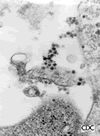|
Electron Micrograph
of West Nile Virus:

( Image from
the
CDC site
on WNV )
|
WEST NILE
VIRUS UPDATE: The current epidemic in the United States of West Nile
Virus (WNV) has focused attention on mosquitoes as vectors of this
disease. WNV first made its appearance in the U.S.
in 1999, and during the Summer of 2000, numerous cases arose in and around New
York City. Deaths of a
number of patients in Greater New York raised concern about the disease,
leading to wide-spread spraying of that area with insecticide. WNV has
now (August 2002) been detected in mosquitoes and/or birds throughout all of
the Eastern U.S., and has caused documented illness in
approximately 200 humans with the deaths of around 20. Members of the
mosquito genus Culex are most frequently
associated with its transmission, but Asian Tiger Mosquitoes have also been
found carrying the virus. Although Aedes albopictus has not been demonstrated to transmit WNV
to humans so far, we expect that it may be implicated with further
study. The rapid spread of the Asian
Tiger Mosquito and its proliferating numbers increase the likelihood of it
transmitting the disease.
West Nile Fever Transmission:
Like other examples of arthropod borne viral (arboviral)
encephalitis, West Nile Fever is caused by an enveloped "+" single
stranded RNA virus, a member of the flavivirus
group. The preferred host for this virus is birds, especially members
of the family Corvidae (Crows, Bluejays,
etc) which presumably constitute the reservoir for the virus. (Dead
Crows are often the first sign of the virus' presense
in a community.) The virus is transmitted by female mosquitoes when,
after picking up the virus from an infected bird, they take another blood
meal and transmit the virus to incidental species such as horses and less
frequently, humans. Transmission of the virus from one human to another
by a mosquito has never been demonstrated. (The human is a "dead
end" host.) It is impossible for one person to catch it directly
from an infected person.
Symptoms of West Nile Fever:
The vast majority of human cases (perhaps as many as 99%) are subclinical, demonstrating no signs or symptoms. A
small minority may notice "flu-like" symptoms of
fever, achiness, fatigue, etc. In a
much smaller fraction of persons, especially
those with weakened immune systems (the elderly, very young, immunosuppressed, etc) the disease can progress to
inflammation and swelling of the brain, a life threatening condition termed
encephalitis.
Symptoms of encephalitis include high fever, neck stiffness, muscle
weakness, disorientation, tremors, convulsions, and worse. Anyone who
has these symptoms should see a physician immediately. As for viral
diseases in general, there is no cure, and supportive measures are the best
that can be offered at this time. There is an excellent review of the
topic at the CDC
site on West Nile Virus .
The frequency of cases of West Nile
Fever should decline with time. As more individuals are
infected and become immune to the virus, the number of
acute cases will decline in proportion to those as of yet
uninfected. (In parts of Africa, the number of
immune individuals in the population approaches 100%.)
Thus in a few years, West Nile Fever, although endemic, is expected to
decline in frequency.
|
